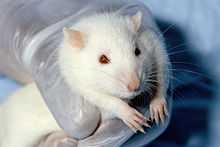Cruelty to Animals Act 1876
The Cruelty to Animals Act 1876 was an Act passed by the Parliament of the United Kingdom (39 & 40 Vict., Public Acts, c. 77.) which set limits on the practice of, and instituted a licensing system for animal experimentation, amending the Cruelty to Animals Act 1849. Its long title was An Act to amend the Law relating to Cruelty to Animals (15 August 1876). The Act was replaced 110 years later by the Animals (Scientific Procedures) Act 1986.
The Act

The Act stipulated that researchers would be prosecuted for cruelty, unless they conformed to its provisions, which required that an experiment involving the infliction of pain upon animals to only be conducted when "the proposed experiments are absolutely necessary for the due instruction of the persons [so they may go onto use the instruction] to save or prolong human life". Furthermore the Act stated that should the experiment occur, the animal must be anaesthetised, used only once (though several procedures regarded as part of the same experiment were permitted), and killed as soon as the study was over.[1] Prosecutions under the Act could be made only with the approval of the Secretary of State.[2] The Act was applicable to vertebrate animals only.
History and controversy
Opposition to vivisection had led the government to set up a Royal Commission on Vivisection in July 1875, which recommended that legislation be enacted to control it. This Act was created as a result, but was criticized by National Anti-Vivisection Society — itself founded in December 1875 — as "infamous but well-named," in that it made no provision for public accountability of licensing decisions. The law remained in force for 110 years, until it was replaced by the Animals (Scientific Procedures) Act 1986,[3] which is the subject of similar criticism from the modern animal rights movement.
Such was the perceived weakness of the Act, that vivisection opponents chose, on at least one occasion — the Brown Dog affair — to incite a libel suit rather than seek a prosecution under the Act.
Penalties
The Act states, in part:
Any person performing or taking part in performing any experiment calculated to give pain, in contravention of this Act, shall be guilty of an offence against this Act, and shall, if it be the first offence, be liable to a penalty not exceeding fifty pounds, and if it be the second or any subsequent offence, be liable, at the discretion of the court by which he is tried, to a penalty not exceeding one hundred pounds or to imprisonment for a period not exceeding three months.
See also
References
- ↑ Kean, Hilda. "An Exploration of the Sculptures of Greyfriars Bobby, Edinburgh, Scotland, and the Brown Dog, Battersea, South London, England," Society and Animals, Volume 1, Number 4, December 2003, pp. 353–373.
- ↑ Mason, Peter. The Brown Dog Affair. Two Sevens Publishing, 1997, p.10
- ↑ "The history of the NAVS", retrieved December 04, 2007.
External links
- Full text of the Act, accessed May 12, 2010.
| ||||||||||||||||||||||||||||||||||
